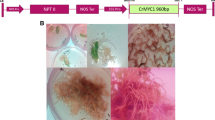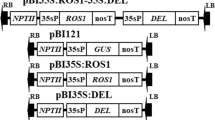Abstract
A number of genes that function in the terpenoid indole alkaloids (TIAs) biosynthesis pathway have been identified in Catharanthus roseus. Except for the geraniol 10-hydroxylase (G10H) gene, which encodes a cytochrome P450 monooxygenase, several of these genes are up-regulated by ORCA3, a jasmonate-responsive APETALA2 (AP2)-domain transcript factor. In this study, the G10H gene was transformed independently, or co-transformed with ORCA3 into C. roseus, using Agrobacterium rhizogenes MSU440. Hairy root clones expressing the G10H gene alone, or both the G10H and ORCA3 genes, were obtained. Alkaloid accumulation level analyses showed that all transgenic clones accumulated more catharanthine, with the highest accumulation level in the transgenic clone OG12 (6.5-fold higher than that of the non-expression clone). Following treatment with ABA, accumulation of catharanthine reached 1.96 mg/g DW in the transgenic clone OG12. The expression levels of TIAs biosynthesis genes in transgenic and non-transgenic clones were also investigated.




Similar content being viewed by others
References
Behnam B, Kikuchi A, Celebi-Toprak F, Kasuga M, Yamaguchi-Shinozaki K, Watanabe KN (2007) Arabidopsis rd29A:DREB1A enhances freezing tolerance in transgenic potato. Plant Cell Rep 26:1275–1282
Bhadra R, Morgan JA, Shanks JV (1998) Transient studies of light-adapted cultures of hairy roots of Catharanthus roseus: growth and indole alkaloid accumulation. Biotechnol Bioeng 60:670–678
Bhatnagar-Mathur P, Devi MJ, Reddy DS, Lavanya M, Vadez V, Serraj R, Yamaguchi-Shinozaki K, Sharma KK (2007) Stress-inducible expression of At DREB1A in transgenic peanut (Arachis hypogaea L.) increases transpiration efficiency under water-limiting conditions. Plant Cell Rep 26:2071–2082
Collu G, Unver N, Peltenburg-Looman AM, van der Heijden R, Verpoorte R, Memelink J (2001) Geraniol 10-hydroxylase, a cytochrome P450 enzyme involved in terpenoid indole alkaloid biosynthesis. FEBS Lett 508:215–220
Da Costa e Silva O, Klein L, Schmelzer E, Trezzini GF, Hahlbrock K (1993) BPF-1, a pathogen-induced DNA-binding protein involved in the plant defense response. Plant J 4:125–135
Favretto D, Piovan A, Filippini R, Caniato R (2001) Monitoring the production yields of vincristine and vinblastine in Catharanthus roseus from somatic embryogenesis. Semiquantitative determination by flow-injection electrospray ionization mass spectrometry. Rapid Commun Mass Spectrom 15:364–369
Gamborg OL, Miller RA, Ojima K (1968) Nutrient requirements of suspension cultures of soybean root cells. Exp Cell Res 50:151–158
Hong SB, Peebles CA, Shanks JV, San KY, Gibson SI (2006) Terpenoid indole alkaloid production by Catharanthus roseus hairy roots induced by Agrobacterium tumefaciens harboring rol ABC genes. Biotechnol Bioeng 93:386–390
Hughes EH, Hong SB, Shanks JV, San KY, Gibson SI (2002) Characterization of an inducible promoter system in Catharanthus roseus hairy roots. Biotechnol Prog 18:1183–1186
Hughes EH, Hong SB, Gibson SI, Shanks JV, San KY (2004) Metabolic engineering of the indole pathway in Catharanthus roseus hairy roots and increased accumulation of tryptamine and serpentine. Metab Eng 6:268–276
Magnotta M, Murata J, Chen J, De Luca V (2007) Expression of deacetylvindoline-4-O-acetyltransferase in Catharanthus roseus hairy roots. Phytochemistry 68:1922–1931
Pasquali G, Porto DD, Fett-Neto AG (2006) Metabolic engineering of cell cultures versus whole plant complexity in production of bioactive monoterpene indole alkaloids: recent progress related to old dilemma. J Biosci Bioeng 101:287–296
Pauw B, Hilliou FA, Martin VS, Chatel G, de Wolf CJ, Champion A, Pre M, van Duijn B, Kijne JW, van der Fits L, Memelink J (2004) Zinc finger proteins act as transcriptional repressors of alkaloid biosynthesis genes in Catharanthus roseus. J Biol Chem 279:52940–52948
Peebles CA, Hughes EH, Shanks JV, San KY (2009) Transcriptional response of the terpenoid indole alkaloid pathway to the overexpression of ORCA3 along with jasmonic acid elicitation of Catharanthus roseus hairy roots over time. Metab Eng 11:76–86
Pino MT, Skinner JS, Park EJ, Jeknic Z, Hayes PM, Thomashow MF, Chen TH (2007) Use of a stress inducible promoter to drive ectopic AtCBF expression improves potato freezing tolerance while minimizing negative effects on tuber yield. Plant Biotechnol J 5:591–604
Rahman L, Kouno H, Hashiguchi Y, Yamamoto H, Narbad A, Parr A, Walton N, Ikenaga T, Kitamura Y (2009) HCHL expression in hairy roots of beta vulgaris yields a high accumulation of p-hydroxybenzoic acid (pHBA) glucose ester, and linkage of pHBA into cell walls. Bioresource Technol 100:4836–4842
Runguphan W, O’Connor SE (2009) Metabolic reprogramming of periwinkle plant culture. Nat Chem Biol 5:151–153
Shadwick FS, Doran PM (2007) Propagation of plant viruses in hairy root cultures: a potential method for in vitro production of epitope vaccines and foreign proteins. Biotechnol Bioeng 96:570–583
St-Pierre B, Vazquez-Flota FA, De Luca V (1999) Multicellular compartmentation of Catharanthus roseus alkaloid biosynthesis predicts intercellular translocation of a pathway intermediate. Plant Cell 11:887–900
Suttipanta N, Pattanaik S, Gunjan S, Xie CH, Littleton J, Yuan L (2007) Promoter analysis of the Catharanthus roseus geraniol 10-hydroxylase gene involved in terpenoid indole alkaloid biosynthesis. Biochim Biophys Acta 1769:139–148
Tikhomiroff C, Jolicoeur M (2002) Screening of Catharanthus roseus secondary metabolites by high-performance liquid chromatography. J Chromatogr A 955:87–93
Van der Fits L, Memelink J (2000) ORCA3, a jasmonate-responsive transcriptional regulator of plant primary and secondary metabolism. Science 289:295–297
Wise AA, Liu Z, Binns AN (2006) Three methods for the introduction of foreign DNA into Agrobacterium. Methods Mol Biol 343:43–53
Woods RR, Geyer BC, Mor TS (2008) Hairy-root organ cultures for the production of human acetylcholinesterase. BMC Biotechnol 8:95
Yamaguchi-Shinozaki K, Shinozaki K (1993) Characterization of the expression of a desiccation-responsive rd29 gene of Arabidopsis thaliana and analysis of its promoter in transgenic plants. Mol Gen Genet 236:331–340
Yamaguchi-Shinozaki K, Shinozaki K (1994) A novel cis-acting element in an Arabidopsis gene is involved in responsiveness to drought, low-temperature, or high-salt stress. Plant Cell 6:251–264
Zhang L, Ding R, Chai Y, Bonfill M, Moyano E, Oksman-Caldentey KM, Xu T, Pi Y, Wang Z, Zhang H, Kai G, Liao Z, Sun X, Tang K (2004) Engineering tropane biosynthetic pathway in Hyoscyamus niger hairy root cultures. Proc Natl Acad Sci USA 101:6786–6791
Acknowledgment
The authors are grateful to Professors J. Memelink (Leiden University, Netherlands) for providing the vectors containing G10H or ORCA3 genes, and Dr. Wang Yan-zhang (Shanghai Institutes for Biological Sciences, China) for providing A. rhizogenes MSU440, and Chen Jun (Shanghai Institutes for Biological Sciences, China) for HPLC analysis. This work was supported by the following grants: the Knowledge Innovation Program of Shanghai Institutes for Biological Sciences, Chinese Academy of Sciences (Grant No. 2007KIP304); the National Basic Research Program of China (Grant No. 2006CB100106; 2010CB126600); the National Natural Science Foundation of China (Grant No. 30571196; 0933ZF11C1; 0933Z411C1); The Ministry of Science and Technology of China (Grant No. 2007AA10Z187); Shanghai Science and Technology Commission (Grant No. 08DZ2270800).
Author information
Authors and Affiliations
Corresponding author
Additional information
Communicated by K. Chong.
Rights and permissions
About this article
Cite this article
Wang, CT., Liu, H., Gao, XS. et al. Overexpression of G10H and ORCA3 in the hairy roots of Catharanthus roseus improves catharanthine production. Plant Cell Rep 29, 887–894 (2010). https://doi.org/10.1007/s00299-010-0874-0
Received:
Revised:
Accepted:
Published:
Issue Date:
DOI: https://doi.org/10.1007/s00299-010-0874-0




